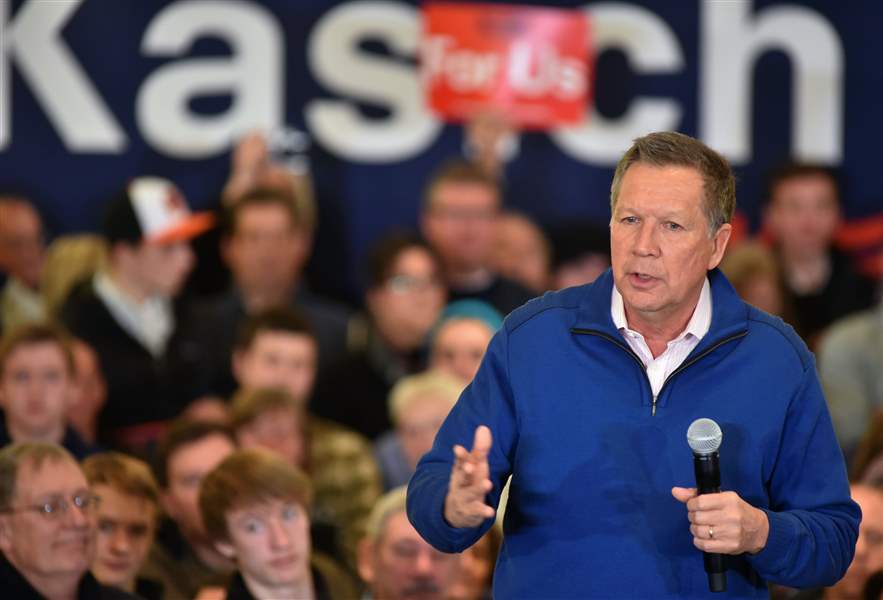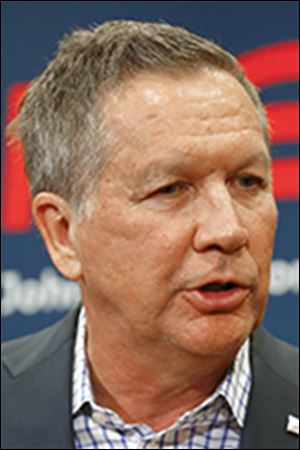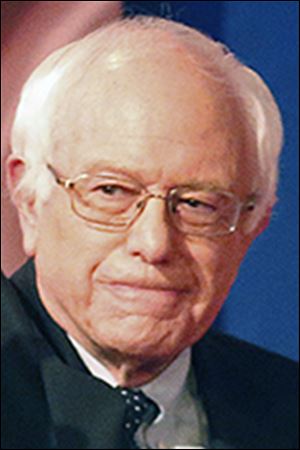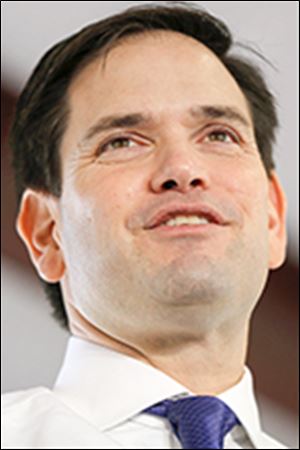
Kasich, Sanders, Rubio offer ideas for Ohio’s economic concerns
3/6/2016
Republican presidential candidate, Ohio Gov. John Kasich speaks at a rally in Traverse City, Mich., Saturday, March 5, 2016. The Michigan primary election is Tuesday, March 8, 2016. (AP Photo - John L. Russelll)
AP
Lower taxes, better education, free health care for all, and capping unnecessary regulations are among the solutions America’s presidential candidates recommend to reverse the decline in middle-class income and manufacturing jobs in Ohio.
The Blade reached out last week to the Democratic and Republican presidential candidates to respond to an Ohio-wide newspaper analysis of the state’s economic condition.

Kasich
The campaigns of Democratic U.S. Sen. Bernie Sanders of Vermont and Republican U.S. Sen. Marco Rubio replied to The Blade’s questions with substantive answers.
A spokesman for Ohio Gov. John Kasich responded, but he criticized the findings as out-of-date, and as failing to take note of the gains that have been made under Mr. Kasich’s administration.
Mr. Kasich has made Ohio’s economic comeback during his six years in office — with the creation of more than 400,000 jobs — the centerpiece of his campaign.
Kasich spokesman Rob Nichols didn’t dispute that Mr. Kasich has had to labor under the burden of a decline in the kind of high-paying manufacturing jobs that enriched a previous generation.
RELATED CONTENT: Among Ohio voters, economy still most important issue ■ Recovery means little for many across state
He said the 4.7 million private-sector jobs in Ohio stand at 65,000 jobs above the pre-recession level of November, 2007.
He said Mr. Kasich faced a “historical disadvantage” when he came into office in January, 2011, and worked to reverse a two-decades long trend. Steps he took included cutting red tape, privatizing economic development, getting the state budget under control, and cutting taxes.
“In response, Ohio’s private sector job creation growth rate ranking has skyrocketed” from 46th to 22nd, as of December, 2015,” Mr. Nichols said.
He said median income and “goods producing jobs” in Ohio have outperformed the national economy under Mr. Kasich. He showed data that median income rose 5.4 percent in Ohio from January, 2011, to January, 2014, while growing 1.8 percent nationally in the same period.
And Mr. Nichols cited Bureau of Labor Statistics data showing that “goods producing jobs” shrank in Ohio by 35.4 percent from 2000 to 2010, and have grown from 2010 to 2015 by 11.1 percent — compared with growth nationally of 10.6 percent.
He said the Kasich campaign welcomes the other Republican hopefuls to come and see what’s happening in Ohio.
“We’re happy to showcase our state as one that got off the mat after the Great Recession and is now humming. Ohio is the model for what can happen nationally when you do those things. We’re thrilled to showcase to these other candidates what that economic success looks like,” Mr. Kasich said.

Sanders
Mr. Sanders pinned the job loss in Ohio in large part on “failed trade policies.”
“These bad trade deals have destroyed good-paying manufacturing jobs in Ohio by incentivizing companies to ship jobs overseas. I have consistently opposed these bad trade deals in Congress. As President, I will work to reverse these trade agreements that have proven so costly to Ohio workers,” Mr. Sanders said in a statement to The Blade.
He said his Medicare-for-All health care plan would take some of the burdensome cost of health care off working Americans and businesses.
“This would provide an important measure of economic security for Ohio families,” he said. Mr. Sanders is proposing to make tuition free at public colleges and universities.
“Finally, to create more jobs in Ohio and across the country, I am proposing a jobs program that would put 13 million Americans back to work by investing $1 trillion in modernizing our infrastructure,” he said.
Mr. Rubio’s office provided a two-page response about Ohio’s economic situation.
“The economy is the No. 1 issue for Ohio voters, and for good reason: employment, wages, and median incomes have fallen, while the costs of health care, education, and living expenses have gone up. We need a president who not only understands the challenges of the 21st century economy, but a president with a comprehensive plan to address them,” Mr. Rubio said in his written statement.

Rubio
Solutions, according to Mr. Rubio, include revolutionizing higher education and skills training and tax code reform.
Tax changes include reduction of a corporate tax rate of 39.2 percent to 25 percent and creating a $2,500 child tax credit for “middle class families.”
“According to nonpartisan estimates, my plan will create millions of jobs, result in a massive increase in investment, and boost after-tax income for all Americans,” Mr. Rubio said.
Also necessary is “a regulatory environment” without unnecessary mandates, he said.
“I have proposed enacting a National Regulatory Budget, which lets Congress put an annual cap on federal regulations so that agencies like the EPA cannot operate without checks and balances,” Mr. Rubio said.
He said he has a comprehensive energy plan to increase domestic production of energy, stop harmful regulations, and modernize an outdated education system to encourage high-paying jobs of the future.
The Blade reached out to the campaigns of Republicans Donald Trump of New York and Sen. Ted Cruz of Texas, and former Secretary of State Hillary Clinton, but did not receive responses.
Contact Tom Troy: tomtroy@theblade.com or 419-724-6058 or on Twitter @TomFTroy.